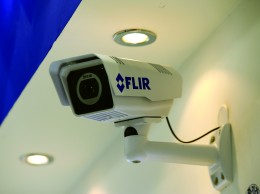While other companies look to the skies for drone business opportunities, Teledyne Technologies is looking to the seas.
The Thousand Oaks-based conglomerate has been investing in so-called autonomous underwater vehicles that are used by oceanographers, oil and gas companies and for military missions. On July 2, Teledyne invested in a San Diego company called Ocean Aero, a startup working on an unmanned vehicle that can float on the ocean surface but could also make subsea dives.
The duck-like drone would extend the range of traditional unmanned subsea vehicles because it could recharge its battery systems with wind and solar systems power on the surface. The terms of the Ocean Aero deal weren’t disclosed, but Teledyne officials said they might acquire the company if the technology is developed successfully.
“We didn’t do this just to make a good investment. We did it because it was indeed strategic,” said Jason VanWees, head of investor relations for Teleydne.
The autonomous underwater vehicle market is tiny. Energy industry research firm Douglas-Westwood estimates the entire global fleet will remain at less than 1,000 vehicles by 2016. Research and Markets, a market research firm, estimates that the industry is a smaller slice of bigger market for remotely operated submarines and is only worth $457 million in 2014. But several firms estimate the market will eventually be worth more than $2 billion.
The Defense Security Service, the arm of the U.S. military that monitors attempts by foreign countries to buy defense-related technologies, said in a 2011 report that it “is very likely that demand for AUVs will increase dramatically over the next several years, especially as more military and commercial capabilities develop.” The group added that “as the technology advances, foreign collectors will almost certainly increase their efforts to satisfy that demand by targeting U.S. cleared [defense] contractors working on AUVs or related systems.”
At Teledyne, the underwater vehicle segment is a small part of its broader portfolio of marine systems, which made up $580.4 million of Teledyne’s $2.3 billion in revenue last year. To a certain extent, the vehicles themselves are vessels to carry all the other products that Teledyne makes for the subsea market. It makes advanced multi-beam sonar that can detect hidden features of the sea floor and can be used to create high-resolution maps and detect oil and gas deposits. It also makes advanced Doppler-effect sensors that can measure current movements at different depths that are used by weather and oceanographic researchers.
Teledyne makes a variety of products for oil and gas companies, from interconnects that let electrical cables link up underwater to flow sensors for underwater pipelines. Teledyne sensors even picked up on what was briefly believed to be the ping from Malaysia Airlines flight 370, which mysteriously disappeared earlier this year. (The pings were later found to have come from an unrelated but man-made source.)
“It’s a market we understand,” VanWees said. “Not just the vehicles, but the sensors themselves.”
Teledyne already has examples of each of the major underwater vehicle technologies in its portfolio. It has battery-powered systems that use propellers to go on shorter missions. For longer missions, it uses underwater gliders, vehicles that can translate the up-and-down movements of small changes in buoyancy into horizontal propulsion. They are slower than battery-powered vehicles but can remain at sea for weeks or months at a stretch because they use so little power.
The duck-like capabilities of the Ocean Aero vehicle would fill out Teledyne’s portfolio. “If you’re hanging out on the surface, you can use solar power and you can use wind for propulsion,” VanWees said. “If it’s a defense application, perhaps you don’t want to be seen and want to go subsea.”
From a defense point of view, VanWees said, autonomous underwater vehicles have all the benefits of their airborne counterparts — they’re lighter, faster and cheaper and keep human operators out of harm’s way.
“They’re not weaponized,” VanWees said. “They’re more defensive — find a mine, or map an ocean floor so you know the ships won’t scrape the ocean floor in Long Beach. Right now, the Navy is buying our gliders, but one of the main reasons they want the gliders is to look at the density of water. The density of water will affect your sonar signals.”
Longer term, Teledyne is making a bet that the market for underwater drones will play out like the one for their cousins in the air. “Ten or 15 years ago, people didn’t really know about [unmanned aerial vehicles] and it was a small market. It’s grown into a substantially larger market,” VanWees said. “We see no reason the marine market won’t develop in a similar way. If someone wants to do an ocean floor map, it’s much cheaper to use an unmanned vehicle than send a huge vessel burning diesel fuel and full of people.”






 Print
Print Email
Email

















